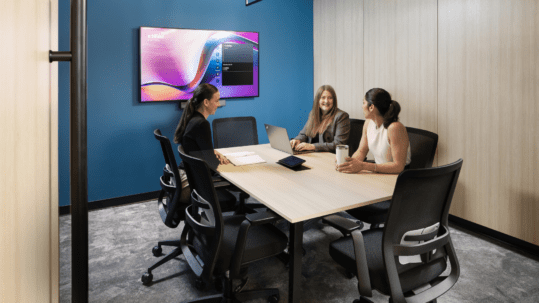Article written & featured by Techcouver
I have met with many tech companies over the years, and it has been fascinating to see how the industry has evolved and how workplace design has changed alongside it. In the past decade, a sequence of quiet design revolutions have modified the way offices are used, obliterating former hierarchies of corner offices and cubicles, and incorporating workplace methodologies from the technology industry into more collaborative, open-plan layouts. The most recent shift during the pandemic, allowed for organizations to pivot and move towards remote work creating a wave of new habits among employees. This latest shift has taught us that being physically present at the office full-time is not required to produce excellent results. So why then are tech companies keeping an office?
We recently hosted a TenantTalks event called Designing the Workplace of Today, where I got to hear firsthand about tenants’ experiences implementing long-term work modalities and systems, as well as how they approach designing their current workspaces. I noticed three major themes emerged from the panelists’ discussion to explain why businesses are in fact maintaining an office and how they blend the physical and the digital in this new paradigm.
1. Building Connection And Human Capital
The first theme that emerged was the importance of offices in connecting employees to the team, its values, and company. An office creates a distinct ambience that cannot be replicated while working remotely. Maintaining a dynamic office culture where people work collaboratively and have fun together generates a special connection that positively impacts the business.
It is easier for employees to be completely involved in the organization when they come into the office on a semi-regular basis. People in the office can work more collaboratively with coworkers, forming a team bond. Furthermore, investing in space where people can come together and build social capital with each other helps to make them more successful as teams. Being at a workplace that is built to emphasize the company’s values fosters a sense of belonging. All these factors contribute to a more engaged workforce. Moreover, it should be noted that companies with a highly engaged workforce are 21 % more lucrative and expand their income four times faster. Overall, getting people together to connect cannot be done online as well as it can be done in person.
2. Work/Life Balance And Mental Health
According to a 2021 Accenture study, 83 percent of Canadian workers say a hybrid model is ideal. Having the option of working remotely while also being able to come into the office allows employees to have a better work/life balance. Several people close to me have told me that it is more difficult to strike a balance when working in a completely remote environment. Another thing I have noticed is that mental health issues have become increasingly widespread.
During the TenantTalks discussion, a couple of panelists advocated for keeping an office so that employees could break their routine and not work 24/7, which they noticed was common for remote workers. Unplugging after work is considerably more difficult when you are at home and do not have to physically leave the office and simply leave your work behind. This struggle, however, does not imply that businesses can continue to operate in substandard conditions in the hopes of being rescued by the need for balance. Instead, businesses must provide employees with a purpose to come to work. You must ensure that your employees have a well-designed space in which to serve the needs of the people and business alike.
This transitions to the last theme I noticed which is customizing offices for the employee experience.
3. Employee Experience (Customization):
Being intentional with all aspects of your workplace strategy is critical. All decisions should be made with the employee experience in mind. For example, instead of having a large office it might be better to have smaller satellite offices nearer to workers’ homes. Carol Graziani the Director of Diversity and Inclusions at Best Buy mentioned this as one of the reasons they decided to relocate from their previous location of 25 years in Burnaby to a smaller space in Mount Pleasant, because so many of their staff and potential employees live closer to central downtown.
Another thing I would like to point out is that social spaces, gathering areas and learning spaces are not enough. Space must be programmed with activities and communicated to employees so that they are adopted and utilized. A social space cannot simply be placed into an office, there must be a purpose for it. For example, a wellness room should include a wellness program to help employees to deal with stress better.
Conclusion:
Organizations have begun to invest in their workplaces in greater numbers than ever before. With the trend towards remote and hybrid working, it is more critical than ever for businesses to provide employees with a reason to come to work. Even in today’s hyper-connected digital world, an office is still necessary to bring people together and establish a sense of community, as well as to encourage employee mental health and give a better work-life balance. An office is a terrific business tool, although its function can alter from being a necessary component of the workday to a monthly meeting hub for team bonding. With a well-thought-out workplace strategy and a well-designed office, you can expect a more engaged and motivated crew.






